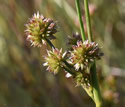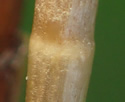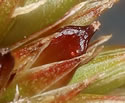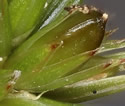Juncus canadensis (Canada Rush)
| Also known as: | |
|---|---|
| Genus: | Juncus |
| Family: | Juncaceae (Rush) |
| Life cycle: | perennial |
| Origin: | native |
| Habitat: | sun; moist to wet; calcareous marshes, fens, bogs, wet ditches, salt flats, shores |
| Fruiting season: | July - October |
| Plant height: | 12 to 40 inches |
| Wetland Indicator Status: | GP: OBL MW: OBL NCNE: OBL |
| MN county distribution (click map to enlarge): |  |
| National distribution (click map to enlarge): |  |
Pick an image for a larger view. See the glossary for icon descriptions.
Detailed Information
Flower: 


![[photo of flower heads]](/udata/r9ndp23q/se/juncus-canadensis-t.jpg) 3 to 50+ flower heads in a compact or open branching cluster at the top of the stem, the branches erect to ascending, the main branches subtended by an erect, leaf-like bract that does not usually overtop the cluster. Each flower head is hemispheric to round, 3 to 10 mm in diameter, with 5 to 50 flowers. Flowers have 6 tepals (petals and similar sepals) in 2 layers, the outer tepals 2.7 to 3.8 mm long and usually slightly shorter than the inner tepals, both sharply pointed at the tip and green to straw-colored to reddish or orange-brown. Flowers have a 3-parted style and usually 3 stamens, sometimes 6, the anthers (tips) about half as long as the filament (stalk).
3 to 50+ flower heads in a compact or open branching cluster at the top of the stem, the branches erect to ascending, the main branches subtended by an erect, leaf-like bract that does not usually overtop the cluster. Each flower head is hemispheric to round, 3 to 10 mm in diameter, with 5 to 50 flowers. Flowers have 6 tepals (petals and similar sepals) in 2 layers, the outer tepals 2.7 to 3.8 mm long and usually slightly shorter than the inner tepals, both sharply pointed at the tip and green to straw-colored to reddish or orange-brown. Flowers have a 3-parted style and usually 3 stamens, sometimes 6, the anthers (tips) about half as long as the filament (stalk).
Leaves and stems: 


![[photo of sheath auricle and leaf partitions]](/udata/r9ndp23q/grass/juncus-canadensis_0811_121223-t.jpg) A flowering stem has 2 or 3 alternate leaves and a single basal leaf. Leaves are 2½ to 8½ inches long, up to 3mm wide, round in cross-section, with cross partitions at regular intervals (may be easier felt than seen). The sheath is open at the front. At the tip of the sheath is a pair of lobes (auricles) 1 to 1.2 mm long, rounded at the tip with a papery band around the edge. Stems are smooth, stout, mostly erect, unbranched, a few from the base forming small, loose clumps.
A flowering stem has 2 or 3 alternate leaves and a single basal leaf. Leaves are 2½ to 8½ inches long, up to 3mm wide, round in cross-section, with cross partitions at regular intervals (may be easier felt than seen). The sheath is open at the front. At the tip of the sheath is a pair of lobes (auricles) 1 to 1.2 mm long, rounded at the tip with a papery band around the edge. Stems are smooth, stout, mostly erect, unbranched, a few from the base forming small, loose clumps.
Fruit: 
![[photo of maturing capsule and fruit]](/udata/r9ndp23q/grass/juncus-canadensis-1-t.jpg) Fruit is a 3-sectioned capsule 3.3 to 4.5 mm long, as long as or slightly longer than the tepals, occasionally much longer, the tip with a long or abrupt taper to a pointed tip, green to dark chestnut brown. Inside are numerous spindle-shaped seeds with long, pale, tail-like appendages at both ends. Seeds are 1.1 to 1.9 mm long including the tails, with a white translucent covering.
Fruit is a 3-sectioned capsule 3.3 to 4.5 mm long, as long as or slightly longer than the tepals, occasionally much longer, the tip with a long or abrupt taper to a pointed tip, green to dark chestnut brown. Inside are numerous spindle-shaped seeds with long, pale, tail-like appendages at both ends. Seeds are 1.1 to 1.9 mm long including the tails, with a white translucent covering.
Notes:
Canada Rush is a somewhat variable species, with multiple variations and forms recognized in some references, but these distinctions are not made in Minnesota populations. The heads are typically hemispheric to round with numerous flowers, in which case they can resemble 2 other Minnesota rushes: Torrey's Rush (Juncus torreyi) and Knotted Rush (Juncus nodosus), both of which also have septate (partitioned) leaves, but neither of which have seeds with long tails. J. torreyi has larger flower heads, up to 15mm in diameter, with up to 100 flowers per head; J. nodosus is typically a smaller plant, less than 20 inches tall, with 15 or fewer heads each with fewer than 30 flowers, the bract of the lowest branch often greatly overtops the cluster, and is strongly rhizomatous, often forming good sized colonies. The only other two Juncus species in Minnesota with tailed seeds are Narrow-panicled Rush (Juncus brevicaudatus) and Vasey's Rush (Juncus vaseyi). J. brevicaudatus has septate leaves like J. canadensis, but has only 2 to 8 flowers per head and the capsules are typically much longer than the tepals. J. vaseyi does not have septate leaves, the flowers are single, not clustered in heads and usually not more than 15 in a cluster, the capsules are greenish and not pointed at the tip.
Native Plant Nurseries, Restoration and Landscaping Services ↓
More photos
 Canada Rush plant
Canada Rush plant Canada Rush plants
Canada Rush plants Canada Rush plants
Canada Rush plants Juncus canadensis with Juncus brevicaudatus
Juncus canadensis with Juncus brevicaudatus septate leaf partition more easily seen when dry, felt when green
septate leaf partition more easily seen when dry, felt when green tepals and fruits may be reddish brown
tepals and fruits may be reddish brown tepals and fruits may be green to straw-colored
tepals and fruits may be green to straw-colored comparison of Juncus brevicaudatus and Juncus canadensis
comparison of Juncus brevicaudatus and Juncus canadensis comparison of Juncus nodosus, J. canadensis, J. torreyi
comparison of Juncus nodosus, J. canadensis, J. torreyi
Photos by K. Chayka taken in Anoka and Ramsey counties. Other photos courtesy Steve Eggers.
Comments
Have you seen this plant in Minnesota, or have any other comments about it?






